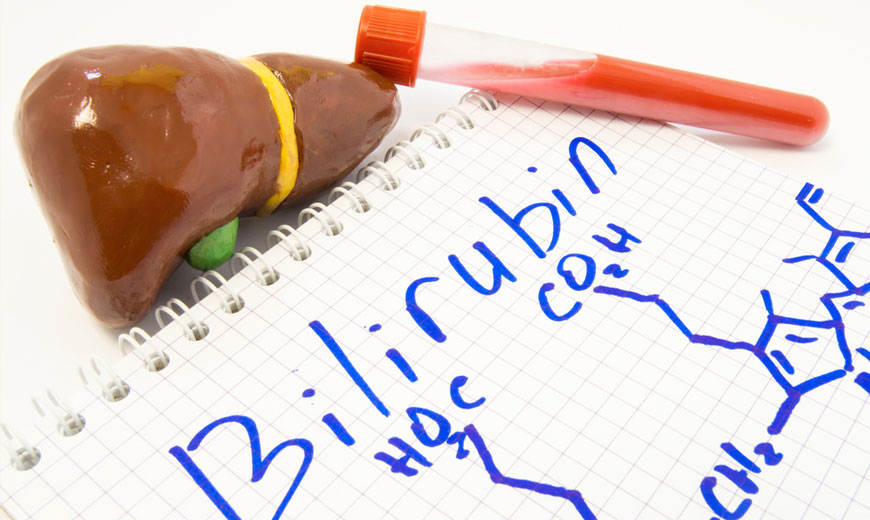Bilirubin is a yellowish pigment that is formed in the liver and excreted in the bile. It is a byproduct of the breakdown of red blood cells and tissues such as muscle and liver cells. When the liver is unable to process bilirubin effectively, it can build up in the blood, leading to elevated bilirubin levels. This condition can manifest as jaundice, where the skin and eyes can take on a yellowish tint.
In this article, we’ll look at the causes, effects, and strategies for managing high blood bilirubin levels.
What is bilirubin?
Bilirubin is a key component that helps digest fat. The liver metabolizes bilirubin, making it water-soluble and allowing it to be excreted from the body through bile and urine.
There are two main types of bilirubin:
- Direct (conjugated) bilirubin: It is water-soluble and has already been processed by the liver, making it ready for elimination from the body.
- Indirect (unconjugated) bilirubin: This type is not processed by the liver and is fat soluble. If not metabolized properly, it can build up in the bloodstream.
Understanding these different types of bilirubin helps in the diagnosis and management of conditions associated with elevated levels of bilirubin in the body.
Indications for high bilirubin levels
Normal total bilirubin levels in adults usually range between 0.2 and 1.3 mg per deciliter (mg/dL). Levels above this range are considered high. In infants, especially newborns, slightly higher levels may be normal and range between 1.0 and 12.0 mg/dL.
Symptoms of high bilirubin
Elevated bilirubin can cause a variety of symptoms.
In adults:
- Jaundice (yellowing of the skin and eyes)
- Dark colored urine
- Pale or clayey stools
- Itching or pruritus
- Fatigue or weakness
- Abdominal pain or discomfort
In infants:
- Jaundice (yellowing of the skin and eyes)
- Poor nutrition or lethargy
- Dark urine
- Pale stools
Causes of high bilirubin
High levels of bilirubin can be caused by liver diseases such as hepatitis or cirrhosis, increased breakdown of red blood cells (hemolysis), and genetic disorders such as Gilbert’s syndrome. Each cause requires different approaches to diagnosis and treatment.
Common causes:
In adults:
- Liver disease: Conditions such as hepatitis, cirrhosis, or liver cancer impair the processing and excretion of bilirubin.
- Hemolysis: Increased breakdown of red blood cells, often due to autoimmune diseases or taking certain medications, increases bilirubin levels.
- Gallstones: Obstruction of the bile ducts by gallstones can prevent the proper excretion of bilirubin.
- Genetic disorders: Genetic disorders such as Gilbert’s syndrome affect bilirubin metabolism.
In infants:
- Neonatal Jaundice: A common condition in newborns that is due to immaturity of liver function.
- Breastfeeding Jaundice: Occurs due to insufficient nutrition, which can lead to dehydration and elevated bilirubin levels.
- Hemolytic disease: Conditions such as Rh or ABO incompatibility can cause red blood cells to break down excessively.
- Infections: Certain infections or liver diseases such as sepsis, urinary tract infections, viral infections or congenital hepatitis can cause bilirubin to rise in newborns.
- Sepsis: Severe infection of the bloodstream can cause inflammation and damage to various organs, including the liver, leading to jaundice.
- Urinary tract infections (UTIs): Bacterial infections in the urinary system can sometimes cause jaundice in newborns.
- Congenital infections: Infections at birth, such as cytomegalovirus (CMV), rubella, or toxoplasmosis, can affect liver function and cause jaundice.
- Congenital hepatitis: Viral hepatitis transmitted from the mother during pregnancy or childbirth can cause inflammation of the liver and jaundice.
Laboratory tests for high bilirubin
Laboratory tests are essential in diagnosing and understanding the causes of high bilirubin levels. They help to identify the root cause and take appropriate treatment.
- Total bilirubin test: This test measures the total amount of bilirubin in the blood, including the direct and indirect types.
- Direct and indirect bilirubin tests: These tests specifically measure the amounts of direct (conjugated) and indirect (unconjugated) bilirubin. Abnormal levels may indicate problems with liver function or red blood cell breakdown.
- AST and ALT levels: These are liver enzymes that can be measured along with bilirubin levels. Elevated AST (aspartate aminotransferase) and ALT (alanine aminotransferase) levels often indicate liver inflammation or damage that contributes to high bilirubin levels.
Additional tests
Various diagnostic tests are crucial to determine the causes of high bilirubin levels and guide effective treatment.
- Liver function tests (LFTs): LFTs are blood tests that measure various enzymes and proteins to assess liver health. Elevated levels of enzymes such as AST and ALT, along with altered levels of proteins such as albumin, can identify liver dysfunction or damage that may be the cause of high bilirubin levels.
- Complete blood count: A CBC measures red and white blood cells, hemoglobin , and other components. It helps identify conditions such as hemolysis (increased breakdown of red blood cells) or anemia that may contribute to elevated bilirubin levels.
- Imaging studies: Ultrasound or CT scans of the liver and bile ducts are used to visualize structural problems. These imaging tests can detect blockages, tumors, or other abnormalities that may be causing high bilirubin levels.
In conclusion:
Lifestyle changes, medication, phototherapy and, if necessary, emergency interventions can help effectively manage elevated bilirubin levels. With symptoms such as jaundice, dark urine or severe abdominal pain, it is important to seek medical attention. Regular checkups and blood tests are key to monitoring bilirubin levels, especially if liver or blood disorders are present.
Sources:
- Abolurin, OO, Senbanjo, IO, Adekoya, AO, & Ajibola, ED (2020). Congenital cytomegalovirus infection as an important cause of infantile cholestatic jaundice: a case report. Pan African Medical Journal, 36. https://doi.org/10.11604/pamj.2020.36.106.20577
- Anand Singh, & Ishwarlal Jialal. (2019, November 6). Unconjugated Hyperbilirubinemia. nih.gov; StatPearls Publishing. https://www.ncbi.nlm.nih.gov/books/NBK549796/
- Ansong-Assoku, B., & Ankola, PA (2023). Neonatal Jaundice. nih.gov; StatPearls Publishing. https://www.ncbi.nlm.nih.gov/books/NBK532930/
- Blake, K. (2023, May 22). Anti Inflammatory Diet 101: What to Eat and Avoid Plus Specialty Labs To Monitor Results. Rupa Health. https://www.rupahealth.com/post/anti-inflammatory-diet
- Bratton, S., Cantu, RM, & Stern, M. (2023, January 17). Breast Milk Jaundice. PubMed; StatPearls Publishing. https://www.ncbi.nlm.nih.gov/books/NBK537334/
- Chen, I., Hsu, L.-S., Yao, C.-S., Chang, J.-T., Wang, H.-P., & Fang, N.-W. (2024). Risk factors for urinary tract infection in infants with unexplained hyperbilirubinemia: a single center case-control study. Frontiers in Pediatrics, 12. https://doi.org/10.3389/fped.2024.1332052


